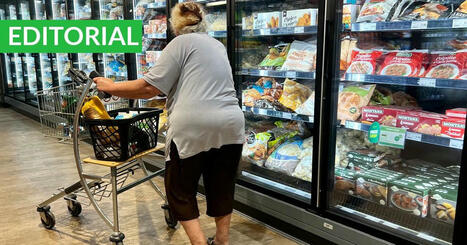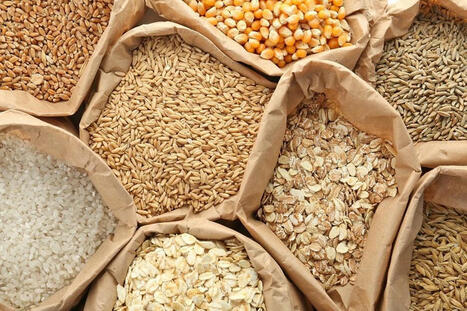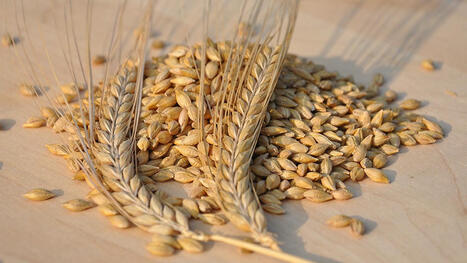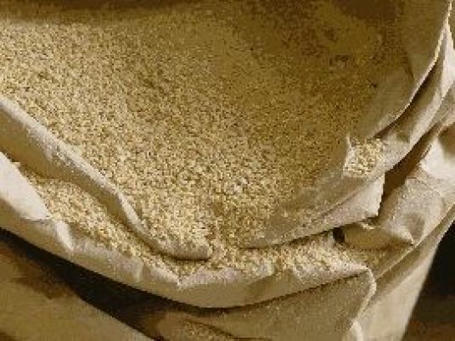 Your new post is loading...

|
Scooped by
CIHEAM News
October 23, 4:18 AM
|
(FranceAgriMer) "Nouvelles prévisions françaises pour la campagne commerciale 2025/26 : les bilans prévisionnels s’allègent. Blé tendre : prévisions de collecte révisées à la baisse, utilisations en alimentation animale et exportations revues en hausse."

|
Scooped by
CIHEAM News
October 6, 5:24 AM
|
(Express TV) "Morocco is set to import over 3 million tons of French wheat this season, roughly 20% of France's total wheat exports. The country’s wheat needs are estimated at about 5 million tons of soft wheat, alongside similar quantities of durum wheat and barley. France is expected to supply around 60% of Morocco's wheat imports, establishing itself as a key partner amid global supply disruption. So far, Morocco has already imported 1 million tons of French wheat this season. French exporters are targeting 15 million tons globally, with a meeting planned in Casablanca to discuss collaboration in the grain sector."

|
Scooped by
CIHEAM News
October 6, 5:05 AM
|
(World Grain) "ISLAMABAD, PAKISTAN — Pakistan’s agriculture sector and farmer-held wheat stocks are in a precarious position resulting from “unprecedented” monsoon flooding since mid-August, likely disrupting the wheat planting schedule for the 2026-27 crop, according to a report from the Foreign Agricultural Service (FAS) of the US Department of Agriculture."

|
Scooped by
CIHEAM News
October 6, 4:11 AM
|
(Reuters) "NEW YORK, Sept 24 (Reuters) - Oil prices climbed about 3% to a seven-week high on Wednesday as a surprise drop in U.S. weekly crude inventories added to a sense in the market of tightening supplies amid export issues in Iraq, Venezuela and Russia."

|
Rescooped by
CIHEAM News
from CIHEAM Press Review
October 6, 6:07 AM
|
Échanges inter-rives : coopérer pour relever les défis agricoles et alimentaires méditerranéens INSCRIPTIONS AUX conférences publiques – Maroc – Meknès Jeudi 9 octobre 2025 9h – 14hÉcole Nationale d’Agriculture(ENAM) S’INSCRIRE France – Montpellier Jeudi 6 novembre 2025 14h – 19hInstitut...

|
Scooped by
CIHEAM News
October 6, 5:25 AM
|
(Grainews) "Canada’s first durum variety classified as resistant to ergot may expand the wheat’s acreage in parts of Western Canada where it’s not been typically grown."

|
Scooped by
CIHEAM News
October 6, 5:30 AM
|
(Zawya) "Purchases were reported at around $259, $260 and $261 a ton cost and freight (c&f) included. The purchase is optional origin but was expected to be substantially sourced from the Black Sea region including Ukraine, Romania, Bulgaria and other countries, traders said."

|
Rescooped by
CIHEAM News
from CIHEAM Press Review
October 6, 6:07 AM
|
Policy makers must focus more attention on how rising food prices affect vulnerable groups like low-income families and retirees

|
Rescooped by
CIHEAM News
from CIHEAM Press Review
October 6, 6:09 AM
|
Drones, capteurs, robots, logiciels de suivi… Pour piloter une agriculture plus durable, les solutions numériques sont souvent prônées. Mais les effets de ces technologies en plein développement sont encore méconnus et peu étudiés. Tour d’horizon avec Pierre La Rocca, doctorant1 en informatique au Laboratoire Bordelais de Recherche en Informatique (LaBRI), pour le 18ème numéro de la revue Sesame (parution en décembre 2025).
Via Chambre d'agriculture de région Pays de la Loire, CIHEAM News

|
Scooped by
CIHEAM News
October 6, 6:03 AM
|
(UkrAgroConsult) "Mauritania has initiated a wheat seed multiplication program under the Arab-Africa Trade Bridges (AATB) initiative, in collaboration with the Arab Center for the Studies of Arid Zones and Dry Lands (ACSAD) and the International Islamic Trade Finance Corporation (ITFC). The project aims to reduce import dependency by cultivating high-yield wheat varieties. The AATB Program support."

|
Scooped by
CIHEAM News
October 6, 4:10 AM
|
(Reuters) "WINNIPEG, Manitoba, Sept 22 (Reuters) - Canada's durum crop has been damaged from rainy, damp conditions, with some farmers holding off on harvesting crops in the hopes of drier weather, according to the country's grain quality agency. Mildew and sprouting damage has appeared in some early crop samples arriving at the Canadian Grain Commission, inspectors said to reporters at its headquarters on Friday. CGC grain inspector Chris Fleury said that durum wheat appears to be particularly affected by the wet conditions."

|
Scooped by
CIHEAM News
October 6, 4:08 AM
|
(Reuters) "MUMBAI, Sept 17 (Reuters) - India's rice stocks in government warehouses climbed over 14% from a year earlier to a record high for early September, while wheat inventories reached a four-year peak on stronger buying from farmers, official data showed on Wednesday."

|
Scooped by
CIHEAM News
October 6, 5:46 AM
|
(Rabobank) "Rising costs and falling prices are squeezing farm margins again, with pressures expected to persist through mid-2027 across major crop regions."
|

|
Scooped by
CIHEAM News
October 6, 5:28 AM
|
(Zawya) "The average price paid for the wheat was $263.38 per ton. The purchase comprised hard milling wheat with 12.5% protein content."

|
Scooped by
CIHEAM News
October 6, 5:07 AM
|
(World Grain) "ROME, ITALY — The benchmark global food commodity index inched up in September compared to a year ago but was nearly 20% lower than the peak reached in March 2022, according to the latest monthly report from the Food and Agriculture Organization (FAO) of the United Nations, released on Oct. 3."

|
Scooped by
CIHEAM News
October 6, 4:14 AM
|
(Miller Magazine) "Despite recent bumper crops in key origins, the global durum wheat sector remains fragile. At the World Durum and Pasta Forum 2025 in Rome, leading analysts and industry executives warned that weather shocks, shrinking premiums over soft wheat, rising logistics costs, and shifting consumption patterns are undermining stability."

|
Scooped by
CIHEAM News
October 6, 5:37 AM
|
(Tehran Times) "TEHRAN – Iran’s wheat production is expected to decline to 13.5 million tons in the 2024/25 crop year, down 2.5 million tons from last season, according to the U.S. Department of Agriculture (USDA)."

|
Scooped by
CIHEAM News
October 6, 5:55 AM
|
(Zerno On-line, translated by UkrAgroConsult) "On September 30, the Turkish Grains Board (TMO) held a tender for the purchase of 255,000 tons of feed barley, Reuters reported."

|
Rescooped by
CIHEAM News
from CIHEAM Press Review
October 6, 6:10 AM
|
CAIRO, Sept 21 (MENA) - Minister of Foreign Affairs, Emigration and Egyptian Expatriates Badr Abdelatty expressed on Sunday Egypt's desire to cooperate with the World Food Programme (WFP) to establish a global hub for grain storage, supply and trade on Egyptian territory to bolster food security and strengthen supply chains in the Middle East.

|
Scooped by
CIHEAM News
September 25, 12:00 PM
|
(Terre-net) "L’enquête menée par les services de FranceAgriMer et Arvalis sur les grains à l’entrée des silos confirme que l’année a été particulièrement favorable à la qualité du blé tendre et du blé dur français, avec de très bons résultats tant pour les critères physiques que pour les qualités technologiques."

|
Rescooped by
CIHEAM News
from CIHEAM Press Review
October 6, 6:06 AM
|
Food inflation is driving changes in diets and retail markets as prices for staples like olive oil skyrocket, impacting vulnerable households.

|
Rescooped by
CIHEAM News
from CIHEAM Press Review
October 6, 6:06 AM
|
The price of the food basket rose again last week and is now 2.07 euros higher (+0.86%), reaching 242.45 euros. This is "one of the highest prices" since DECO PROteste began tracking the price of this basket of essential items.

|
Scooped by
CIHEAM News
October 6, 5:10 AM
|
(World Grain) "In its Sept. 22 report updating wheat, corn and rice, the FAS projected Egypt to harvest a slightly larger wheat crop at 9.2 million tonnes in 2025-26, up from 9 million tonnes in the previous season. Imports are seen growing in the same manner to 12.7 million tonnes, up from 12.5 million tonnes."

|
Scooped by
CIHEAM News
September 25, 6:14 AM
|
(CNN) "Many parts of world face are predicted to endure periods of unprecedented extreme water scarcity, which could happen as soon as this decade in certain hotspots."

|
Rescooped by
CIHEAM News
from CIHEAM Press Review
October 6, 6:11 AM
|
"En juin 2025, l’OCDE a publié un rapport sur les perspectives mondiales en matière de sécheresses, à partir d’une revue de littérature et des expériences de pays membres."
|



 Your new post is loading...
Your new post is loading...
























